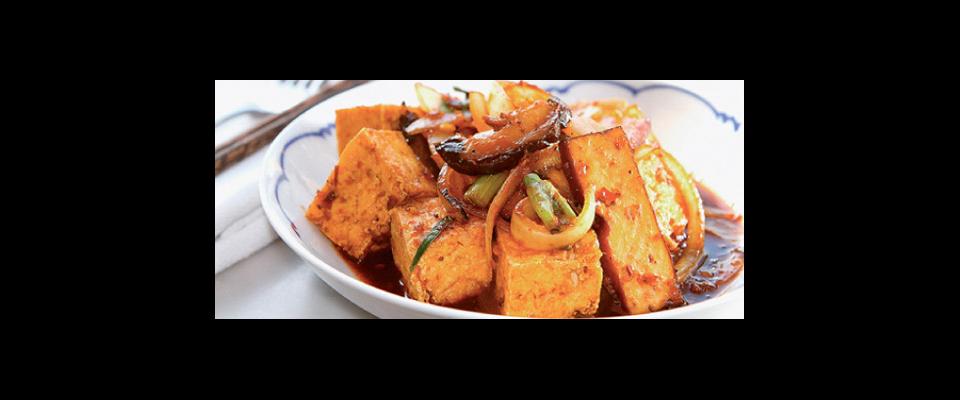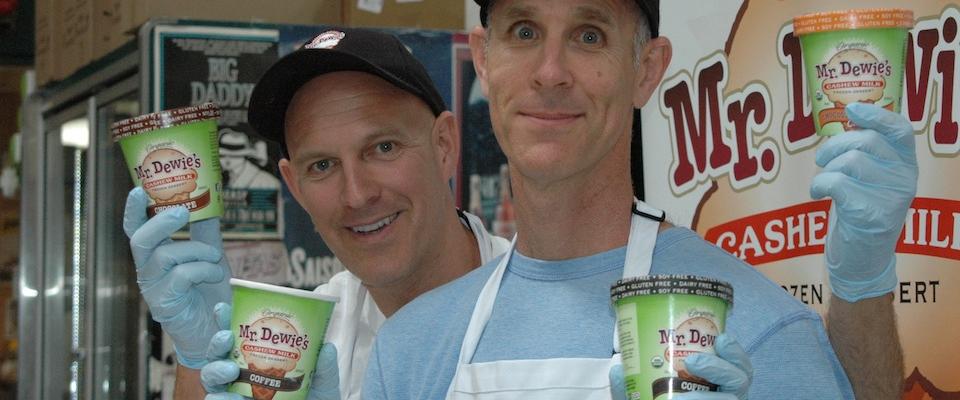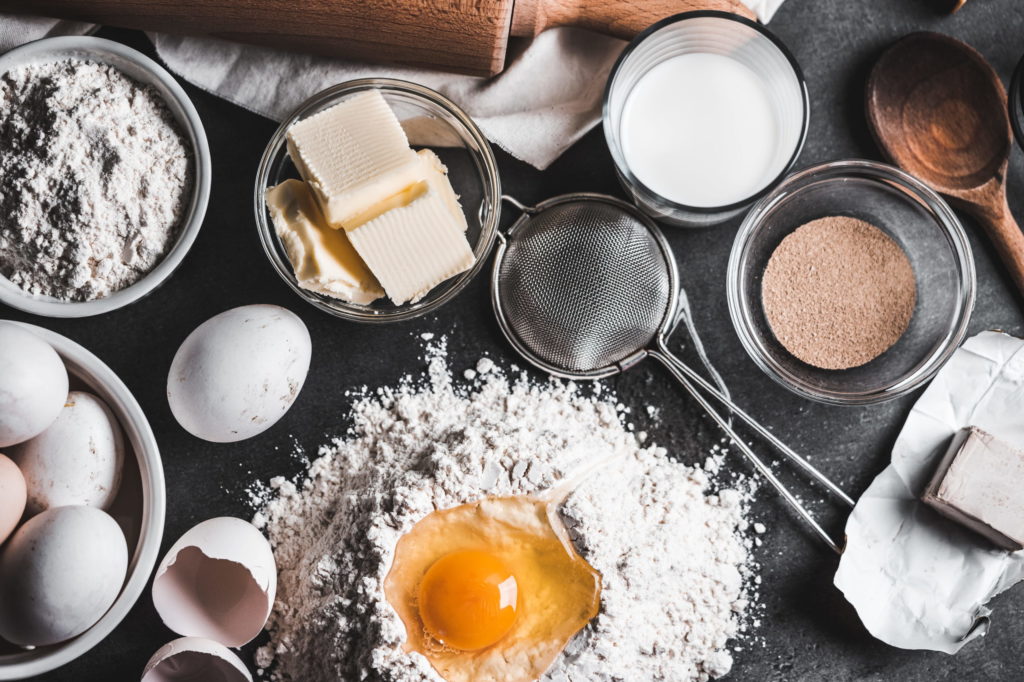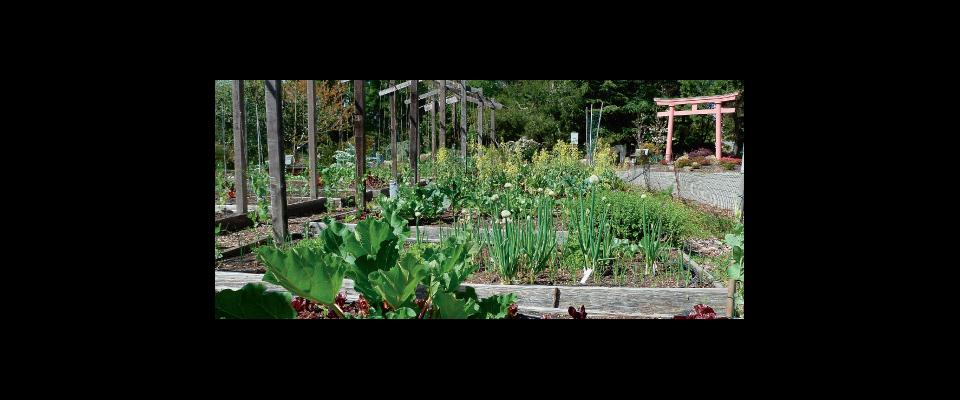Scharffenberger leads a campaign to make tofu cool.
John Scharffenberger’s taste buds have been good to him. They guided him to success in his premium chocolate and sparkling wine companies, which he has since sold for millions. Scharffenberger established a U.S. audience for these gourmet goods in what had previously been a European-dominated luxury market.
Today, the 59-year-old is taste-testing three decidedly different new ventures on the food front: a specialty meat, a fermented vegetable, and a humble little legume seeking serious artisan status. That last one may turn out to be his biggest challenge, given the American palate. This June, Scharffenberger ’73 signed on as the CEO of the Hodo Soy Beanery in Oakland, a small tofu factory that crafts products from organic, non-GMO soybeans sourced from cooperatives in the Midwest. The company makes fresh tofu, yuba (tofu skins), and soymilk, as well as prepared dishes such as spicy braised tofu, poached yuba loaf, and soy omelette.
The effervescent Scharffenberger, a lanky, youthful man with strikingly blue eyes, expects consumers will share his enthusiasm for his current culinary projects because, as he says matter-of-factly, they taste really good. He’s trying his hand at making a Spanish-style cured meat, Iberico ham, named for its region of origin and considered the best of its kind around the world. Along with partner Mac Magruder, a Northern California rancher of grass-fed beef and pork, Scharffenberger raises hogs bred for this purpose from wild pigs they trapped themselves, and fattens these pigs on a diet of acorns to elicit just the kind of taste and texture he’s seeking.
A fermented food fan, Scharffenberger also makes sauerkraut, using produce from his vast vegetable garden. It’s a small operation—he sells his cabbage condiment to hot-dog maker Let’s Be Frank in San Francisco. (This being the Bay Area, these are gourmet dogs made from grass-fed beef that comes from cows, raised in a sustainable environment, whose résumés are posted on the company website.)
But would anyone have predicted that the erudite entrepreneur would one day find himself peddling soybean products? Tofu, an Asian staple, has largely been viewed in the United States as a hippie health food, not a hip new food. Hodo hopes to change that perception for good. Scharffenberger himself never cared much for tofu until a few years ago when he was strolling through the Berkeley Farmers’ Market and tried what he thought were spicy noodles; he dubbed them delicious and was curious to learn more. First lesson: The “noodles” were actually yuba strips made from the skin of soymilk.
He chatted with Minh Tsai, founder of Hodo, which began as a small, family-run business in San Jose in 2004. Tsai wanted to replicate the kind of fresh tofu he’d eaten as a child in his native Vietnam. When most Americans think of tofu, they picture industrially produced, hermetically sealed plastic packages filled with white rubbery blocks soaking in stale, milky water. Such food would be unrecognizable and unpalatable to many in Asia, says Tsai.
Convinced that Tsai had something good cooking, Scharffenberger invested in the company and came on as a director in 2008. By the time he joined, Hodo had already made impressive headway championing a product that has a reputation for being bland or boring. Tsai started out peddling at farmers’ markets and now sells to local groceries such as Whole Foods. Award-winning chefs have discovered the joys of cooking with Hodo’s soy, including Daniel Patterson, owner of Coi in San Francisco, who has sung the praises of Hodo’s yuba strips in The New York Times Magazine. Cal dropout Charles Phan, owner of the wildly popular Slanted Door, dishes up the company’s tofu, as do chefs at vegetarian mecca Greens.
Scharffenberger quickly saw how he could help Hodo grow their bean business. “When I first got here they had one truck, a few coolers, and some ice, and they were running around distributing the product themselves,” says Scharffenberger from the company’s modest office above the beanery’s production area. “I thought: I can help them figure out the operations end. I’m good at talking up a product.” He says that Tsai and his crew have a good palate for pairing soy with flavors and textures that win over people—like his own mother—who would ordinarily turn up their noses at tofu. Hodo is currently working on a line of tea-infused bean blocks; their yuba strips are popular among new converts.
To satisfy increasing demand, Hodo moved to an upgraded 12,000-square-foot facility in Oakland in late 2009. The leased site, a former candy factory, has been remodelled and houses state-of-the-art stainless steel tofu-making equipment. In 2010 the company also welcomed a new CEO: John Scharffenberger.
Scharffenberger shrugs off the suggestion that soybeans are a harder sell than, say, chocolate and wine. It’s all about getting the word out and getting people sampling quality goods, he maintains. It’s a model that helped transform his business in the 1990s, when he opened his chocolate factory to the public. Consumers today take knowing their food purveyors—and where their food comes from—for granted, but that was a novel concept 20-plus years ago.
Hodo is following suit. “Our tours are modelled after John’s chocolate factory tours,” says Tsai. “It’s important to be transparent and for people to see how this product is made. We think that by revealing the tofu-making process and demystifying this food we’ll generate interest in our products.”
The timing is right for tofu, as more people reduce their meat consumption and seek out vegetarian protein sources without sacrificing flavor. And Hodo is located in just the right spot to truly take off. Oakland is a relatively affordable incubator for new food businesses, centrally located in the Bay Area, and home to a vibrant restaurant scene and food culture.
Scharffenberger should know. The rise of Scharffen Berger Chocolate Maker is the stuff of legend. In 1996, he started the company with physician Robert Steinberg. Steinberg, who died in 2008, approached the venture with a scientist’s need to experiment; Scharffenberger brought sales and marketing savvy and helped scour the globe to find the best cacao for the company’s beans-to-bar chocolate. Their product was unapologetically dark and expensive at a time when most Americans favored cheap milk chocolate. Scharffenberger first tried to wow the wholesale crowd but found his brand’s sweet spot when he began hawking small blocks at the Ferry Building Farmers’ Market in San Francisco.
In 2005, mass-market giant Hershey’s bought the company credited with helping spark the U.S. artisan chocolate industry. Purists lament the sale, but Scharffenberger is philosophical about how things played out. When Hershey reps came calling, the Scharffen Berger company at first said no. But then Hershey offered so much money it would have been silly, he says, not to accept the deal. Besides, most of the board wanted to sell. He is quick to note that the corporation has been a pleasure to consult with and is run by a nonprofit foundation.
These days, Scharffenberger divides his time between the city and the country. A couple of days a week he calls a North Berkeley cottage home. When not at Hodo he attends meetings for the various boards he serves on, including the Berkeley Foundation Board, College of Natural Resources Board, and Botanical Gardens Board of Advisors.
The rest of the week he retreats to his 30-acre property in Philo in the Anderson Valley area of Mendocino County. There, he lives in a simple, Italian country-style rammed-earth house nestled among redwoods and oaks. In the garden he designed he grows about half of his own food. He plants what he likes to eat: celery, peas, carrots, kale, Dutch flat cabbage (this variety is key to his ‘kraut making), and quinoa.
Philo is where he works on his pork project, a labor of love: After more than a year of salting, drying, and curing, the meat is just ready for sampling. Scharffenberger, never one to hurry a quality item onto the market, says he’s still in the experimental phase for the ham, which won’t launch before September 2012.
This food guru may inherit his business acumen from his late father, a finance guy who bought and sold companies on a large scale. His dad, also an avid beekeeper, got him hooked on his outdoor hobbies; he and his brothers helped the old man with garden projects on the family’s 18-acre home in Southern California. One of six kids, Scharffenberger traces his love of the land back to his childhood when he witnessed farms disappearing rapidly only to be replaced by houses.
When Scharffenberger came to Cal, he designed his own major, called biogeography, because, well, it didn’t exist. “I really wanted to be in agricultural land planning,” he says. “I wanted to study biology, plant pathology, botany, soil science, hydrology and geology, zoology, and climatology. A bit of this and a bit of that. So I came up with this major, the professors in the geography department named it biogeography, but it was really agricultural geography.”
With his interest in ag, Scharffenberger found his way into food through dirt, not dining. He spent his summers in Santa Cruz working in raised-bed gardens and vineyards, influenced by the revered master gardener Alan Chadwick, a British-born practitioner of French intensive-style, biodynamic gardening. After graduating, Scharffenberger continued to work in vineyards. He loved a drop of bubbly as much as the next bon vivant, so he set out to make a Champagne-like sparking wine. Considering the Napa Valley too hot to produce the right type of grapes, the innovator just tried his luck in a cooler climate, on family land in nearby Anderson Valley.
It was a risk: Americans called anything with bubbles back then “champagne,” a label that can only be attached to sparking wines from the eponymous province in northern France. Defying the odds, he found a market for his fine wine. Scharffenberger Cellars started selling sparkling wine in 1981 from a garage near Ukiah; the wine went on to earn rave reviews from critics and consumers before it was bought in 1991 by a French luxury goods company and rebranded. (The name has since been restored by the latest owner.)
“John has such commitment to quality and he’s an incredible visionary who spends half his time with his head in the clouds and half his time in the field,” says Larry Bain of Let’s Be Frank, who is eagerly awaiting his next shipment of Scharffenberger sauerkraut. “He takes his time, but you know whatever food he produces it’s going to be extraordinary.”
Given his success and outside-the-box thinking, it’s not surprising that nascent food companies seek out Scharffenberger as a consultant. He also talks shop with students at the London Business School and routinely offers words of wisdom to students at Berkeley’s Haas School of Business.
His advice for budding entrepreneurs, whether food focused or not: “Make something you love, fix something that’s broken, help people in need,” he says. “Do what you’re good at and the rest will follow.”





















